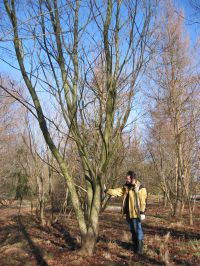redvein maple - Acer rufinerve
English name:
redvein maple
Scientific name:
Acer rufinerve
Family:
Aceraceae (Maple family)
Height:
up to 15 M
Flowering:
early spring before leaf unfolding
Range:
Honshu, Shikoku, Kyushu, Yakushima, Japan
 |
 |
The 27 year old Acer rufinerve in the picture is from seed collected in the wild on Daisen mountain on the southern part of Honshu Island in Japan. It can be found in the middle of our maple woodland, south of the second grass plain after one enters the Arboretum; square 1410 position 2216.
Plant description:
The remarkable snake bark maples are certainly one of the highlights of the Arboretum in winter. The striking, white, stripes on the stems and branches is due to waxes accumulating in longitudinal fissures of the expanding bark. With time the striping disappears as the bark becomes corky. At an intermediate stage, a diamond bark pattern is formed (see photos). The eye catching bark patterns are best preserved in shade, such as on the north sides of the trees, or in our maple woodland. When exposed to the elements the pattern in the bark disappears as a corky bark forms. These are trees for the woodland garden, or the shady courtyard. Acer rufinerve is the fastest growing snake bark maple here in Hørsholm. It appears to be well adapted to the Danish climate although our oldest plants are only 27 years old.
We have 19 examples of Acer rufinerve in our collection in Hørsholm. Our oldest living plants come from the Nordic Arboretum Councils expedition to Japan in 1976. This expedition was extremely useful for introducing new hardy provenances of many Japanese species to the Nordic countries. Our most vigorous trees derive from seed collected at 1300 M elevation on Mt. Daisen on Honshu Island.
Acer rufinerve was first reported in Denmark in 1880 in the now closed, Hesede nursery. This nursery was a pioneer in introducing plants to Denmark. The remains of the nursery now form the dendrological park called Paradishaven.
Acer rufinerve is one of the most common snakebark maples in cultivation. The beauty of the bark with its white stripes, always attracts attention. The leaves turn red to orange in the autumn adding to its usefulness as a garden plant. It is reported to not hybridize easily, so garden seed probably comes true.
These deciduous tree-like shrubs or small trees grow slowly to reach 15 m in height. As in other maples the leaves are opposite on the shoot, but they not very maple-like in shape. They are 3 lobbed with tufts of rusty hairs on the dark green underside that disappear in summer. Such hairs are not found on rapidly growing shoots. The species name rufinerve refers to these rusty red hairs in the vein axels. The margins are doubly saw-toothed, and the base is heart shaped. A lack of red stripes in the bark is one clue to identifying this particular species. The fruit is a woody samara (winged and typical for a maple) with a rounded nutlet.
References:
Bean, W.J. 1976 Trees and Shrubs Hardy in the British Isles Vol I. A-C. Pp 229. Bean and Murray publishers.
Justice, D. 2002. Snake Bark Maples at UBC Botanical Garden. Davidsonia 13: 44-58
Lange, J. 1994. Kulturplanternes Indførselshistorie i Danmark. (Introduction History of Cultivated Plants in Denmark). Jordbrugsforlaget, Frederiksberg C.
Mitchell, A. & Ødum S. 1983. Træer i Nordeuropa. Gads forlag, Copenhagen, pp. 354-355.
Rushforth, K. 1999. Trees of Britain and Europe. Harper Collins Publisher. 1336 Pp.
